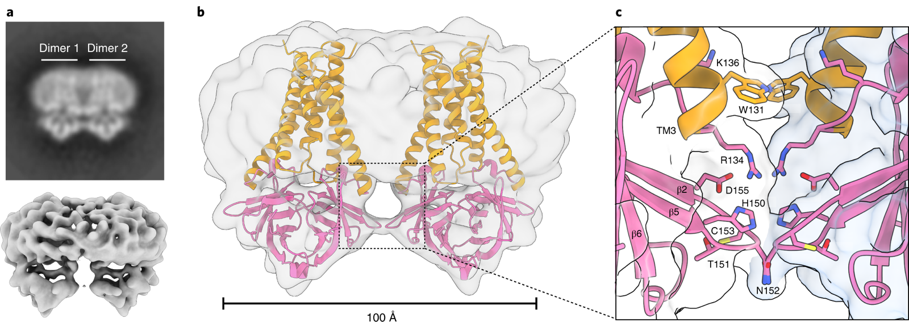Drug Discovery
Cryogenic electron microscopy (cryo-EM) is a powerful analysis method for biological molecule assembly. After flash freezing, the biological macromolecules exist in amorphous ice with a nearly natural state. After data collection and processing, high-resolution molecular structures are obtained and can be analyzed to identify potential drug molecules. Cryo-EM is a perfect fit for basic research in structural biology and helps accelerate structure-based drug discovery.
 Figure 1. Structure of tetrameric 3a in lipid nanodiscs. (Kern D M, et al. 2021)
Figure 1. Structure of tetrameric 3a in lipid nanodiscs. (Kern D M, et al. 2021)
New diseases or emergent epidemics require de novo drug design, which requires the accumulation of a large amount of basic research. In the field of drug development, cryo-EM technology has been used for drug discovery. Although it is a cutting-edge technology, there are already structure-based drugs developed using cryo-EM in clinical trials, such as the COVID-19 antibody "cocktail".
We are very happy to cooperate with research institutions and companies for potential drug discovery. We believe that cryo-EM is playing an increasingly important role in structure-based drug design, advanced structure characterization of biologics, and quality control during cold-chain transportation. Our experts have years of experience in cryo-EM and can assist you with every step from sample preparation to data processing.
Drug discovery targets:
- GPCRs
- Ion channels
- Antibodies
- E3-Ligases
- PROTAC
- Antivirus
- Antitumor
- RNA Transcription Regulation Analysis
- Structure-based Drug Design (SBDD) Services
- γ-Secretase
Our service advantages:
- Experts with years of experience in cryo-EM
- Simple and fast user interface
- Timely after-sales services
- Highly automated and precisely controlled equipment
- High throughput sample screening services
If you are interested in our drug discovery service, please feel free to contact us. We are looking forward to cooperating with you.
Ordering Process
Reference
- Kern D M, Sorum B, Mali S S, et al. Cryo-EM structure of SARS-CoV-2 ORF3a in lipid nanodiscs. Nature Structural & Molecular Biology. 2021: 1-10.

